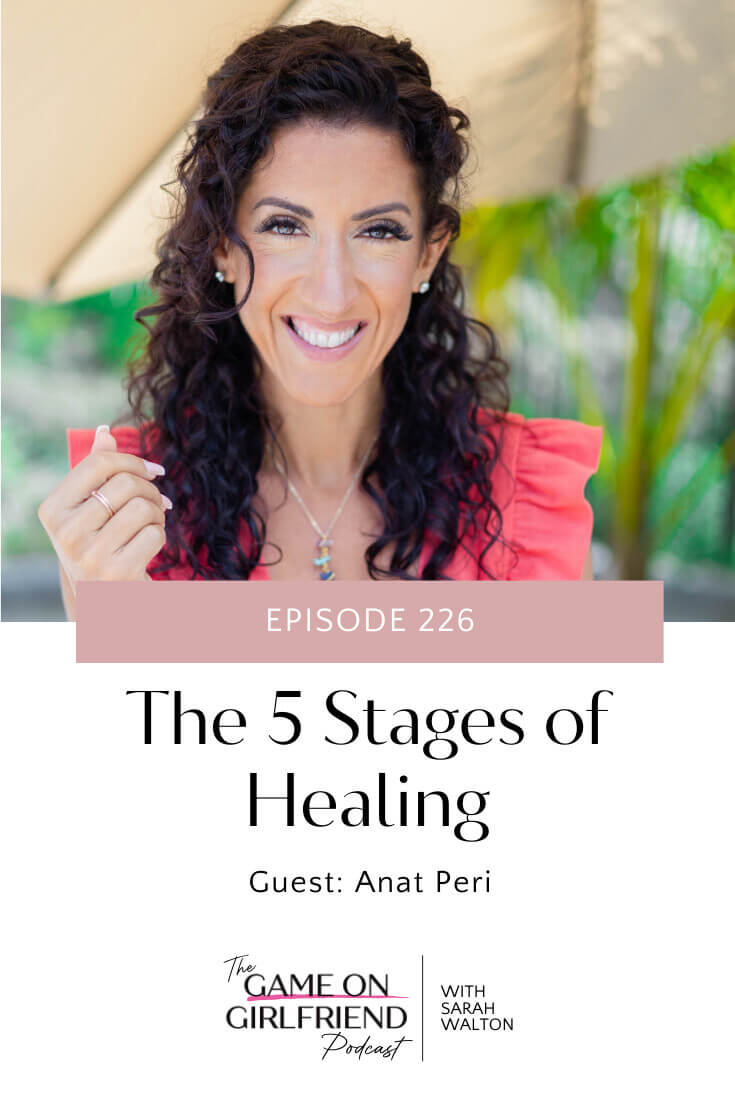Episode 226: The 5 Stages of Healing With Anat Peri

The stories that pull at us, that keep us anxious and upset, that we tell ourselves over and over -- I'm not good enough. This isn't going to work. I've already tried this. – they all come from what we haven't healed.
Today’s guest, Anat Peri has dedicated her life to teaching people how to heal, specifically when it comes to generational trauma. Working with Anat is an opportunity for us to examine where we are still being held back by stories we may not even realize are running the show.
In this episode, Anat walks us through the five stages of healing and gives us a timeline for how long it takes to truly heal, instead of just recognizing that there's SOMETHING to heal.
Anat is the CEO and founder of Training Camp for the Soul and renowned Creator of Master Facilitator of the TCS Method™. Her approach to healing and personal growth isn't merely informative, it's a profound experience that creates lasting change.
Journey to healing career
Anat says self-improvement found her at 25. She did her first self-development program and instantly felt at home. She loved witnessing people having breakthroughs and discovering who they really are.
But her business wouldn’t come for another 10 years. She says she felt like an imposter at the time. But she has no regrets; she herself was healing and seeking the tools she needed.
“When I met my mentor, I experienced what true transformation is, which is not a walk in the park on a beautiful sunny day; it's a walk through a burning forest, and there are dragons to slay,” says Anat. “It's messy, it's uncomfortable, it's scary, it's painful. It's all the fields. It's the full spectrum of our feelings and our emotions.”
When Anat was ready, she jumped from finance and took the leap to start her business. After discovering what she needed for herself – healing her self-esteem and anxiety – she quit her job and borrowed $5,000 from her father to get started.
She grew her business organically with word of mouth and networking. She started out coaching, and now mentors others with a certification program.
5 Stages of Healing
Whether you're listening in and you are on your own healing journey, or you're a practitioner and you have clients understanding the five stages is going to show you either what stages you've skipped or what the stages are to guide you.
Stage 1: Awareness
Everyone comes with some awareness, but there is so much depth and exploration, even just in that stage of healing such as learning what safety strategies you use that keep you stuck. What limiting beliefs are running the show?
If you’re on your own healing journey, use a journal to dump everything unfiltered that is showing up and triggering you. Then go back and connect the dots by circling anywhere that you wrote “I feel … I am …” which will connect you back to your inner child. Your inner child is your emotion – it’s the part of you that feels and is holding your limiting beliefs.
A lot of times there's a lot of noise in our head. There are many characters. You only hear the loudest one, a lot of times it's not the inner child that we're hearing. We're hearing our protector, which is our ego. We're hearing the inner critic. And so doing this exercise is a way that you yourself can tap into the awareness of what you actually need to bring to consciousness.
Stage 2: Acceptance
This is the hardest healing stage for people to get past; it's the stage that where people need the most support, says Anat. Acceptance means letting go that there's anything to fix or change, and most of the time there's still this programing in us who judges and wants it to change.
It's about being with it with nothing to change, nothing to fix, and therefore, learning to expand your nervous system's capacity to handle more. Because all that life is handing us, whether it's challenges or opportunities creates some experience, some energy, some emotion sensation in our body.
For some people, it's normal for them to live in chaos and anxiety that feels familiar. But then being in peace and harmony, suddenly they're hypervigilant and self-sabotage it because it's unfamiliar.
In this stage, it's learning to observe what is happening at the level of sensation. We label things as “good or bad,” which becomes "I feel this way, how do I fix it?" Instead, ask yourself where do you feel it in your body? Describe the sensation. When you speak in sensation, there is no good or bad – there just is.
“I want you to think about acceptance like you're in the ocean … and there's waves,” says Anat. “Your role in acceptance is you're learning to ride the wave instead of being afraid of it and dunking your head under or just breathing. You're riding it. You're learning to ride the wave of your emotion.”
Stage 3: Getting to the root
The third stage of healing is getting to the root, which is like a deeper exploration. It ties into some of the discoveries in awareness because it asks, “Who did you learn this from?”
It might be a parent that you’re copying or rebelling against. Who modeled this to me? Whose energy is this? If it's mom, then like a lot of times in getting to the root, you might ask yourself, “Can you imagine a time when you experienced this?” and get connected to what it was like for your younger self to witness or experience that.
You’re not going to do this with deep trauma, but in a lot of instances you can revisit and repair and give yourself what you needed in that moment. When we get to the root, we are really discovering who we are versus what we learn.
Stage 4: Reparenting and Rewiring
Anat says most people can get through stage three and have a big release. But then the task becomes are you rewiring? Are you declaring what's possible and available now that wasn't before for yourself with yourself?
If you don't go out in the world and now give a new command, a new direction, you're just going to reinforce the old. Some people get addicted to the relief, but you're still not making lasting change internally. It’s in having that new declaration, and not falling back into the things that are habitual, that we can move to the final stage of healing.
Stage 5: Integration, education and stabilization
Anat likes to use the metaphor that our lives are a movie, and we’ve been playing certain archetypes and roles. When you reach stage five of the healing process, you are editing the script and introducing a new main characters with a lot of lines. It’s not going to happen overnight, that integration – it will take time and practice.
We get to bring that same practice of practicing that new belief and integrating it into our lives. So, how does someone who has this belief show up every day? What actions can I take? It's a lot about taking action.
It's also about education because you may be stepping into a role that you've never played before, just like actors. You can read the book. You can listen to the podcast. You can find someone that models it already and copy from the best to educate yourself.
And then the stabilization happens. If you're shifting from being a people pleaser your whole life to finding your voice and having boundaries, you're looking at about 18 months to fully integrate that.
It's not a question of whether you're going to fall off the horse. It's how quickly can you recognize it and get back in alignment. Healing is just like planting a new seed in the garden. You can't just then leave it. You have to check on it every day and water it and give it the right amount of sunlight and all that before it germinate starts to sprout, and then it starts to grow, but it's still fragile. But then 18 months later, it's solid, you're good, and you don't even remember what it was like to be that other person.
Binge More Game On Girlfriend™ Podcast Episodes

Freedom in your business starts here. Make the revenue that allows you to finally exhale.
Download my Freedom Calculator and discover exactly how much your business needs to make so you can be truly free.



